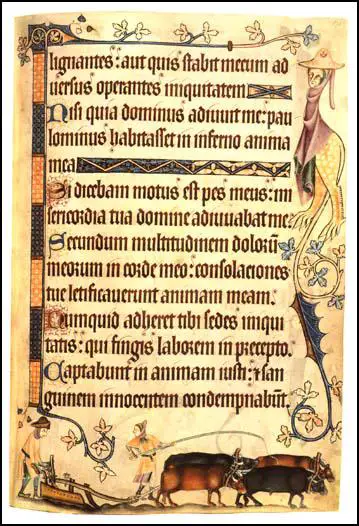Illustrated Manuscripts
The the Middle Ages books often included drawings and pictures to illustrate the text. These pictures were important as many of the people who looked at the books could not read or write. In some cases the writer of the book did his or her own illustrations. However, most books were produced in a team rather than an individual. Often based in a monastery, the team would include an author, scribe and artist.
The most common picture books produced by monks were bibles. These bibles would be illustrated with famous scenes from the life of Jesus. Books on the lives of famous saints such as Thomas Becket were also popular. These religious books were used to teach people about Christianity. One of the books that has survived was produced by Holkham, Leicestershire. The book includes 230 scenes from the Old and New Testaments and would have been very helpful to priests teaching illiterate peasants about religion.
Rich people sometimes commissioned scribes and artists to produce books for them called psalters. These books contained the person's favourite psalms (religious songs that were sung or chanted in church). As well as religious pictures these books often included illustrations that were personal to the person who commissioned the book.
One of the most important of these was the one commissioned by Sir Geoffrey Luttrell, in about 1325. At the beginning of the book is a picture of the Luttrell family. As well as the usual collection of saints and figures from the Bible, the book also includes a collection of pictures that illustrate everyday life of the Luttrell estate.
These were not the first rural scenes to be included in psalters. What makes the illustrations in the Luttrell psalter so important is that they are the most detailed and realistic pictures of everyday life that have survived from the Middle Ages. The artist (we do not know his or her name) produced a range of pictures that has given historians vital information of what life must have been like for ordinary people in the 14th century.

These books were very expensive to produce. We know this because some of the account books of people who commissioned the illustrated books have survived. In 1383, Abbott Nicholas of Westminster decided he wanted a new missal (a book that contains details of the masses to be performed during the year). The book took two years to produce and cost £34 (several thousand pounds in today's money).
In the early Middle Ages nearly all illustrated manuscripts were produced by monks. However, by the 15th century artists in the towns began to takeover this work. Although they rarely signed their work, tax records suggest that these artists were often women.
Primary Sources
(1) Thomas Walsingham, Deeds of the Abbots (c. 1420)
He (Matthew Paris)... wrote down fully in his books, the deeds of great men in Church and State... Moreover he was also a good workmen in gold and silver... in carving and in painting, that he is believed to have left no equal in this world.
(2) Christine de Pisan, Book of the City of Ladies (1405)
I know a woman today, named Anastasia, who is so learned and skilled in painting manuscript borders and miniature backgrounds that one cannot find an artisan in all the city of Paris... who can surpass her... People cannot stop talking about her. And I know this from experience, for she has executed several things for me which stand out among the paintings of the great masters.
(3) Janet Backhouse, The Illuminated Books of Gothic England (1987)
Matthew Paris was born about 1200 and died in 1259... St Albans was a popular staging post and Matthew entertained the leading personalities of the day from both church and state... Matthew was basically a historian... He was also an accomplished artist, adding with his own hand the coloured drawings that embellish most of his original manuscripts.
Student Activities
Illuminated Manuscripts in the Middle Ages (Answer Commentary)
The Battle of Hastings (Answer Commentary)
William the Conqueror (Answer Commentary)
The Feudal System (Answer Commentary)
The Domesday Survey (Answer Commentary)
Thomas Becket and Henry II (Answer Commentary)
